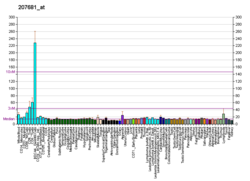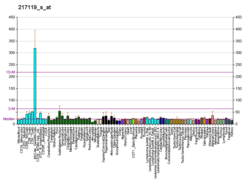CXCR3
Chemokine receptor CXCR3 is a Gαi protein-coupled receptor in the CXC chemokine receptor family. Other names for CXCR3 are G protein-coupled receptor 9 (GPR9) and CD183. There are three isoforms of CXCR3 in humans: CXCR3-A, CXCR3-B and chemokine receptor 3-alternative (CXCR3-alt).[5] CXCR3-A binds to the CXC chemokines CXCL9 (MIG), CXCL10 (IP-10), and CXCL11 (I-TAC)[6] whereas CXCR3-B can also bind to CXCL4 in addition to CXCL9, CXCL10, and CXCL11.[7]
Expression
[edit]CXCR3 is expressed primarily on activated T lymphocytes and NK cells,[8] and some epithelial cells. CXCR3 and CCR5 are preferentially expressed on Th1 cells, whereas Th2 cells favor the expression of CCR3 and CCR4. CXCR3 ligands that attract Th1 cells can concomitantly block the migration of Th2 cells in response to CCR3 ligands, thus enhancing the polarization of effector T cell recruitment.
Signal transduction
[edit]Binding of CXCL9, CXCL10, and CXCL11 to CXCR3 is able to elicit increases in intracellular Ca2++ levels and activate phosphoinositide 3-kinase and mitogen-activated protein kinase (MAPK).[9] Detailed signaling pathway has not yet been established, but may include the same enzymes that were identified in the signaling cascade induced by other chemokine receptors.
Function
[edit]CXCR3 is able to regulate leukocyte trafficking. Binding of chemokines to CXCR3 induces various cellular responses, most notably integrin activation, cytoskeletal changes and chemotactic migration. CXCR3-ligand interaction attracts Th1 cells and promotes Th1 cell maturation.
As a consequence of chemokine-induced cellular desensitization (phosphorylation-dependent receptor internalization), cellular responses are typically rapid and short in duration. Cellular responsiveness is restored after dephosphorylation of intracellular receptors and subsequent recycling to the cell surface. A hallmark of CXCR3 is its prominent expression in in vitro cultured effector/memory T cells, and in T cells present in many types of inflamed tissues. In addition, CXCL9, CXCL10 and CXCL11 are commonly produced by local cells in inflammatory lesion, suggesting that CXCR3 and its chemokines participate in the recruitment of inflammatory cells.[10] Additionally, CXCR3 has been implicated in wound healing.[11]
Clinical significance
[edit]CXCR3 has been implicated in the following diseases atherosclerosis,[12] multiple sclerosis,[13] pulmonary fibrosis,[14] type 1 diabetes,[15] autoimmune myasthenia gravis, nephrotoxic nephritis,[16] acute cardiac allograft rejection,[17] allergic contact dermatitis,[18] and possibly Celiac Disease.[19] It may also have implications in lung tissue repair after exposure to cigarette smoking.[20] Development of agents to block CXCR3-ligand interactions may provide new ways to treat these diseases. In addition, CXCR3 has been implicated in inflammatory brain damage in central nervous system (CNS) infections[21][22][23][24][25][26]
Cardiovascular implications
[edit]Evidence from pre-clinical and clinical investigations has revealed the involvement of CXCR3 and its ligands in several cardiovascular diseases (CVDs) of diverse etiologies including atherosclerosis, hypertension, Kawasaki disease, myocarditis, dilated cardiomyopathies, Chagas, cardiac hypertrophy and heart failure, as well as in heart transplant rejection and transplant coronary artery disease (CAD).[5][27] CXCL9-10-11 have been recognized to be valid biomarkers for the development of heart failure and left ventricular dysfunction in two pilot studies, suggesting an underlining correlation between levels of the interferon (IFN)-γ-inducible chemokines and the development of adverse cardiac remodeling.[28] [29]
Pharmacology
[edit]Recent reports indicate that there is a significant interest for the identification of small-molecule antagonists of CXCR3.[30] Several small molecules [31] were found to constitute a promising series of functional antagonists of CXCR3 that could be developed into new therapeutic agents for the treatment of inflammatory disorders such as rheumatoid arthritis, inflammatory bowel disease, multiple sclerosis and diabetes. More recently the first QSAR study concerning antagonists of CXCR3 has been published in the literature. The in silico model provides a time- and cost-effective tool for the screening of existing and virtual libraries of small molecules as well as for designing of novel molecules of desired activity.[32]
See also
[edit]References
[edit]- ^ a b c GRCh38: Ensembl release 89: ENSG00000186810 – Ensembl, May 2017
- ^ a b c GRCm38: Ensembl release 89: ENSMUSG00000050232 – Ensembl, May 2017
- ^ "Human PubMed Reference:". National Center for Biotechnology Information, U.S. National Library of Medicine.
- ^ "Mouse PubMed Reference:". National Center for Biotechnology Information, U.S. National Library of Medicine.
- ^ a b Altara R, Manca M, Brandão RD, Zeidan A, Booz GW, Zouein FA (April 2016). "Emerging importance of chemokine receptor CXCR3 and its ligands in cardiovascular diseases". Clinical Science. 130 (7): 463–478. doi:10.1042/CS20150666. PMID 26888559.
- ^ Clark-Lewis I, Mattioli I, Gong JH, Loetscher P (January 2003). "Structure-function relationship between the human chemokine receptor CXCR3 and its ligands". The Journal of Biological Chemistry. 278 (1): 289–295. doi:10.1074/jbc.M209470200. PMID 12417585.
- ^ Lasagni L, Francalanci M, Annunziato F, Lazzeri E, Giannini S, Cosmi L, et al. (June 2003). "An alternatively spliced variant of CXCR3 mediates the inhibition of endothelial cell growth induced by IP-10, Mig, and I-TAC, and acts as functional receptor for platelet factor 4". The Journal of Experimental Medicine. 197 (11): 1537–1549. doi:10.1084/jem.20021897. PMC 2193908. PMID 12782716.
- ^ Qin S, Rottman JB, Myers P, Kassam N, Weinblatt M, Loetscher M, et al. (February 1998). "The chemokine receptors CXCR3 and CCR5 mark subsets of T cells associated with certain inflammatory reactions". The Journal of Clinical Investigation. 101 (4): 746–754. doi:10.1172/JCI1422. PMC 508621. PMID 9466968.
- ^ Smit MJ, Verdijk P, van der Raaij-Helmer EM, Navis M, Hensbergen PJ, Leurs R, et al. (September 2003). "CXCR3-mediated chemotaxis of human T cells is regulated by a Gi- and phospholipase C-dependent pathway and not via activation of MEK/p44/p42 MAPK nor Akt/PI-3 kinase". Blood. 102 (6): 1959–1965. doi:10.1182/blood-2002-12-3945. PMID 12750173.
- ^ "Entrez Gene: CXCR3 chemokine (C-X-C motif) receptor 3".
- ^ Yates CC, Whaley D, Kulasekeran P, Hancock WW, Lu B, Bodnar R, et al. (August 2007). "Delayed and deficient dermal maturation in mice lacking the CXCR3 ELR-negative CXC chemokine receptor". The American Journal of Pathology. 171 (2): 484–495. doi:10.2353/ajpath.2007.061092. PMC 1934531. PMID 17600132.
- ^ Mach F, Sauty A, Iarossi AS, Sukhova GK, Neote K, Libby P, et al. (October 1999). "Differential expression of three T lymphocyte-activating CXC chemokines by human atheroma-associated cells". The Journal of Clinical Investigation. 104 (8): 1041–1050. doi:10.1172/JCI6993. PMC 408576. PMID 10525042.
- ^ Sørensen TL, Tani M, Jensen J, Pierce V, Lucchinetti C, Folcik VA, et al. (March 1999). "Expression of specific chemokines and chemokine receptors in the central nervous system of multiple sclerosis patients". The Journal of Clinical Investigation. 103 (6): 807–815. doi:10.1172/JCI5150. PMC 408141. PMID 10079101.
- ^ Jiang D, Liang J, Hodge J, Lu B, Zhu Z, Yu S, et al. (July 2004). "Regulation of pulmonary fibrosis by chemokine receptor CXCR3". The Journal of Clinical Investigation. 114 (2): 291–299. doi:10.1172/JCI16861. PMC 449741. PMID 15254596.
- ^ Frigerio S, Junt T, Lu B, Gerard C, Zumsteg U, Holländer GA, et al. (December 2002). "Beta cells are responsible for CXCR3-mediated T-cell infiltration in insulitis". Nature Medicine. 8 (12): 1414–1420. doi:10.1038/nm792. PMID 12415259.
- ^ Panzer U, Steinmetz OM, Paust HJ, Meyer-Schwesinger C, Peters A, Turner JE, et al. (July 2007). "Chemokine receptor CXCR3 mediates T cell recruitment and tissue injury in nephrotoxic nephritis in mice". Journal of the American Society of Nephrology. 18 (7): 2071–2084. doi:10.1681/ASN.2006111237. PMID 17538187.
- ^ Hancock WW, Lu B, Gao W, Csizmadia V, Faia K, King JA, et al. (November 2000). "Requirement of the chemokine receptor CXCR3 for acute allograft rejection". The Journal of Experimental Medicine. 192 (10): 1515–1520. doi:10.1084/jem.192.10.1515. PMC 2193193. PMID 11085753.
- ^ Smith JS, Nicholson LT, Suwanpradid J, Glenn RA, Knape NM, Alagesan P, et al. (November 2018). "Biased agonists of the chemokine receptor CXCR3 differentially control chemotaxis and inflammation". Science Signaling. 11 (555): eaaq1075. doi:10.1126/scisignal.aaq1075. PMC 6329291. PMID 30401786.
- ^ Lammers KM, Lu R, Brownley J, Lu B, Gerard C, Thomas K, et al. (July 2008). "Gliadin induces an increase in intestinal permeability and zonulin release by binding to the chemokine receptor CXCR3". Gastroenterology. 135 (1): 194–204.e3. doi:10.1053/j.gastro.2008.03.023. PMC 2653457. PMID 18485912.
- ^ Nie L, Liu ZJ, Zhou WX, Xiang RL, Xiao Y, Lu B, et al. (April 2010). "Chemokine receptor CXCR3 is important for lung tissue damage and airway remodeling induced by short-term exposure to cigarette smoking in mice". Acta Pharmacologica Sinica. 31 (4): 436–442. doi:10.1038/aps.2009.192. PMC 4007663. PMID 20208554.
- ^ Xu J, Neal LM, Ganguly A, Kolbe JL, Hargarten JC, Elsegeiny W, et al. (June 2020). "Chemokine receptor CXCR3 is required for lethal brain pathology but not pathogen clearance during cryptococcal meningoencephalitis". Science Advances. 6 (25): eaba2502. Bibcode:2020SciA....6.2502X. doi:10.1126/sciadv.aba2502. PMC 7299622. PMID 32596454.
- ^ Campanella GS, Tager AM, El Khoury JK, Thomas SY, Abrazinski TA, Manice LA, et al. (March 2008). "Chemokine receptor CXCR3 and its ligands CXCL9 and CXCL10 are required for the development of murine cerebral malaria". Proceedings of the National Academy of Sciences of the United States of America. 105 (12): 4814–4819. Bibcode:2008PNAS..105.4814C. doi:10.1073/pnas.0801544105. PMC 2290783. PMID 18347328.
- ^ Sorensen EW, Lian J, Ozga AJ, Miyabe Y, Ji SW, Bromley SK, et al. (April 2018). "CXCL10 stabilizes T cell-brain endothelial cell adhesion leading to the induction of cerebral malaria". JCI Insight. 3 (8). doi:10.1172/jci.insight.98911. PMC 5931132. PMID 29669942.
- ^ Hirako IC, Ataide MA, Faustino L, Assis PA, Sorensen EW, Ueta H, et al. (November 2016). "Splenic differentiation and emergence of CCR5+CXCL9+CXCL10+ monocyte-derived dendritic cells in the brain during cerebral malaria". Nature Communications. 7 (1): 13277. Bibcode:2016NatCo...713277H. doi:10.1038/ncomms13277. PMC 5097164. PMID 27808089.
- ^ Amin DN, Rottenberg ME, Thomsen AR, Mumba D, Fenger C, Kristensson K, et al. (November 2009). "Expression and role of CXCL10 during the encephalitic stage of experimental and clinical African trypanosomiasis". The Journal of Infectious Diseases. 200 (10): 1556–1565. doi:10.1086/644597. PMID 19827943.
- ^ Mehla R, Bivalkar-Mehla S, Nagarkatti M, Chauhan A (October 2012). "Programming of neurotoxic cofactor CXCL-10 in HIV-1-associated dementia: abrogation of CXCL-10-induced neuro-glial toxicity in vitro by PKC activator". Journal of Neuroinflammation. 9 (1): 239. doi:10.1186/1742-2094-9-239. PMC 3533742. PMID 23078780.
- ^ Altara R, Mallat Z, Booz GW, Zouein FA (2016). "The CXCL10/CXCR3 Axis and Cardiac Inflammation: Implications for Immunotherapy to Treat Infectious and Noninfectious Diseases of the Heart". Journal of Immunology Research. 2016: 4396368. doi:10.1155/2016/4396368. PMC 5066021. PMID 27795961.
- ^ Altara R, Gu YM, Struijker-Boudier HA, Thijs L, Staessen JA, Blankesteijn WM (2015). "Left Ventricular Dysfunction and CXCR3 Ligands in Hypertension: From Animal Experiments to a Population-Based Pilot Study". PLOS ONE. 10 (10): e0141394. Bibcode:2015PLoSO..1041394A. doi:10.1371/journal.pone.0141394. PMC 4624781. PMID 26506526.
- ^ Altara R, Manca M, Hessel MH, Gu Y, van Vark LC, Akkerhuis KM, et al. (August 2016). "CXCL10 Is a Circulating Inflammatory Marker in Patients with Advanced Heart Failure: a Pilot Study". Journal of Cardiovascular Translational Research. 9 (4): 302–314. doi:10.1007/s12265-016-9703-3. PMID 27271043. S2CID 41188765.
- ^ Watson RJ, Allen DR, Birch HL, Chapman GA, Galvin FC, Jopling LA, et al. (January 2008). "Development of CXCR3 antagonists. Part 3: Tropenyl and homotropenyl-piperidine urea derivatives". Bioorganic & Medicinal Chemistry Letters. 18 (1): 147–151. doi:10.1016/j.bmcl.2007.10.109. PMID 18032038.
- ^ Watson RJ, Allen DR, Birch HL, Chapman GA, Hannah DR, Knight RL, et al. (December 2007). "Development of CXCR3 antagonists. Part 2: Identification of 2-amino(4-piperidinyl)azoles as potent CXCR3 antagonists". Bioorganic & Medicinal Chemistry Letters. 17 (24): 6806–6810. doi:10.1016/j.bmcl.2007.10.029. PMID 17964154.
- ^ Afantitis A, Melagraki G, Sarimveis H, Igglessi-Markopoulou O, Kollias G (February 2009). "A novel QSAR model for predicting the inhibition of CXCR3 receptor by 4-N-aryl-[1,4] diazepane ureas". European Journal of Medicinal Chemistry. 44 (2): 877–884. doi:10.1016/j.ejmech.2008.05.028. PMID 18619714.
External links
[edit]- "Chemokine Receptors: CXCR3". IUPHAR Database of Receptors and Ion Channels. International Union of Basic and Clinical Pharmacology.
- CD183+Antigen at the U.S. National Library of Medicine Medical Subject Headings (MeSH)
- Human CXCR3 genome location and CXCR3 gene details page in the UCSC Genome Browser.






